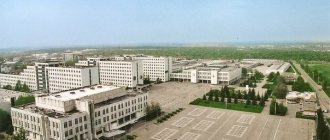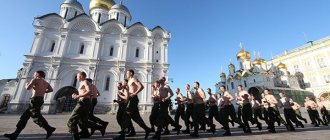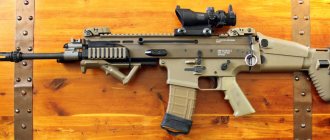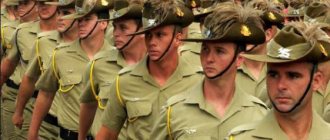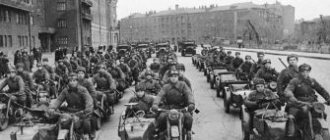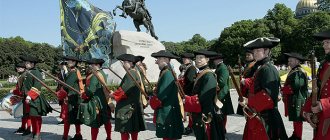05/07/2018 Category: Motorized rifle troops
- 2 Eyewitness impressions
- 3 Instructions for Mom
- 4 Parcels and letters
- 5 Calls to the unit
- 6 Phones
- 7 Regiment location
- 8 Your visit
8.1 Drive to the Semenovsky regiment (Chernyshevsky military town):
- 8.2 Drive to the village. Mosrentgen:
- 8.3 Drive to the training center (Zyuzino village):
8.3.1 Train+Bus
- 8.3.2 Machine
The 1st Separate Rifle Regiment Semenovsky (military unit 75384) was created for the defense and protection of facilities of the central military command authorities, the main headquarters of the branches and branches of the Armed Forces (in Moscow), the main and central departments of the Ministry of Defense, and a number of other military facilities.
Story
On April 16, 2013, the President of the Russian Federation signed the Decree: “In order to revive the glorious military historical traditions, I decide to assign the honorary name “Semenovsky” to the 1st separate rifle regiment and henceforth call it: the 1st separate rifle regiment Semenovsky.” The Semenovsky regiment (military unit 75384) included rifle battalions of the 27th separate motorized rifle brigade (MSBR) of the Western Military District, which previously performed the same tasks as the regiment. The history of the “Semyonovtsy” began on June 5, 1683, when Peter I decided to create a “funny” army near Moscow, in the village of Semenovskoye. By 1691 it had grown into a real regiment, called the Semenovsky Regiment in 1687, and the Semenovsky Life Guards Regiment in 1700. He became famous in the Northern War, the capture of Ochakov, and the Battle of Borodino.
Our Semenovsky regiment (military unit 75384) is not its direct successor. In 2012, military unit 75384 was considered “a new large military police formation of the Western Military District”: the direct predecessor of the regiment in the protection of important state and military facilities is the Security Company, created under the administration of the commandant of the RVSR (Revolutionary Military Council of the Republic) on October 7, 1919. This is - birthday of military unit 75384. On May 3, 2014, military unit 75384 Semenovsky Regiment received a new type of Battle Banner.
Battle banner of the Semenovsky regiment
Banner of the Preobrazhensky Regiment
The regiment received its first banner at the time of its founding by Peter the Great. Subsequently, the appearance of the banner underwent changes several times.
Soldiers of the regiment with its historical banners
Emperor Alexander I awarded the Preobrazhensky soldiers a special insignia - the St. George Regimental Banner with the inscription “For their heroic deeds in the battle of August 17, 1813 at Kulm.”
St. George's Regimental Banner - award of the Emperor
Nowadays, all the historical banners under which the Preobrazhensky soldiers served in different eras can be seen in the Museum of Military Uniforms of the Russian Military Historical Society.
The modern banner of the Preobrazhensky Regiment is used during regimental rituals, including the ancient ceremony of farewell to the Battle Banner of the unit, which is carried out by conscript soldiers and sergeants leaving for the reserve. This ritual is held outside the military camp where the Preobrazhensky Regiment is located, so residents and guests of Moscow can watch the ceremony.
During the farewell ceremony with the Battle Banner
Eyewitness impressions
Every day, one battalion of the Semenovsky regiment (about 400 people) goes on duty in 30 guards. On average, a fighter receives up to 100 outfits per year. The selection criteria for the regiment are special. Height from 170 cm, proportional build, etc. Higher education, good reputation and plans to work in law enforcement agencies are desirable. Most recruits remain in the regiment's training center until the Oath, then depart for their permanent location. Some - future sergeants - remain for training. They take 4 tests from a psychologist (neuropsychic stability, communication skills, memory, physical condition) and 7 exams: special training, drill, physical, fire training; tactics, Charters, RCBZ (radio, bio- and chemical protection). Those who pass the exams receive the rank of junior sergeant and are sent to their posts; some remain in training as platoon commanders and squad commanders. Those who do not pass will receive a record of “attended the training course” and will become privates.
Sleeve patch for military unit 75384
Military unit 75384 loves sports. If the temperature is above “-10” in the morning, exercise outside. Each company has a corner of sports equipment, access is free. Sports events - Tuesday and Thursday from 17.00 to 17.50. Both officers and private Semyonovites regularly participate in various army sports competitions. Living conditions are good everywhere. In Mosrentgen there is a stadium, a swimming pool, an ice rink, a sports town, a museum, a park of wheeled combat vehicles and a shooting range, and nearby there is a town for contract soldiers with their families. All barracks of the Semenovsky regiment are newly renovated. There is a store on the training grounds in Zyuzino. In addition, on Sundays the children have an official “quiet hour” - from 16:00 it is time to relax. However, in military unit 75384 there are also complaints - about the relationship between soldiers and command, “grandfathers” and “spirits”. That is, hazing...
Parcels and letters
Mosrentgen, military unit 75384: the parcel will be delivered to the regiment; translation - receive at the post office (800 m from the part). Zyuzino: tell the soldier when the package was sent, and most importantly, when it arrived. He will contact the unit commander, who will submit the relevant lists for approval. With an issued pass (and an accompanying officer), the fighter goes to the post office, usually on Saturday. Check the postman's phone number with the Parents Committee. Postal addresses:
- Semenovsky regiment (3rd and 4th rifle battalions + separate companies): 115093, Moscow, Bolshaya Serpukhovskaya street, 35, building 1, military unit 75384, battalion, company. FULL NAME.
- 1st, 2nd rifle battalions: 142771, Moscow region (New Moscow), Leninsky district, village. Mosrentgen, military unit 75384, battalion, company, full name. (These battalions are stationed here, on the territory of the 27th Motorized Rifle Brigade, in connection with the renovation of the Chernyshevsky barracks.)
- Training battalion: 140142, Moscow region, Ramensky district, village. Zyuzino, military unit 75384, training battalion, company, full name.
Features of the uniform of the Preobrazhensky Regiment
The first Guards regiments each consisted of two fusilier (rifle) battalions and a company of grenadiers - a selected unit armed with 18th-century hand grenades called "grenades".
The uniform of a fusilier soldier and the uniform of a grenadier soldier differed only in the headdress. Shooters were required to wear woolen hats, and grenade throwers were required to wear grenadier hats.
This is what the Preobrazhenians looked like in Peter’s times
The top of the soldier's clothing consisted of a white shirt, a black bow tie, a dark green camisole, a caftan, and a cape. Bottom - dark green pants and stockings of the same or red color. The soldiers put on boots.
The caftan was made of cloth, with copper buttons, a hem just above the knees, sleeves that did not cover the wrists, with red cloth cuffs, and a red fabric lining. In front, below the waist, there were pockets fastened with 4 buttons.
The camisole, worn under the caftan, was cut in a similar way, but was distinguished by the absence of cuffs, shorter length and width.
The epancha was a wide raincoat to be worn in cold and rainy weather, knee-length, sleeveless, and fastened at the neck with a loop and hook.
The pants are knee-length, with buttons on the side seams. The shoes are blunt-toed, with a copper buckle. During campaigns, soldiers were sometimes given boots instead.
Under the hat, it was prescribed to wear shoulder-length hair. The charter required that the beard be shaved and that the mustache be worn combed up.
The uniform of non-commissioned officers (military personnel with the rank of corporal to ensign) differed from the soldier's in several details:
- gold braid on the cuffs, pockets, side seams of the trousers, the same on the brim of the fusilier's hat, gold embroidery on the hat of the grenadier officer;
- a wig with curls, obligatory in the ceremonial ranks;
- elk leather gloves;
- white tie;
- white and red feather decoration on the headdress (plume);
- gilded buttons;
- dark green lining of the caftan instead of a red lining.
Officer uniforms were made from higher quality fabrics and leather.
The chief officer (rank from warrant officer to captain) had a uniform of the Preobrazhensky Regiment that was different from that of a non-commissioned officer:
- a silver breastplate with a gilded border, depicting a crown and St. Andrew's cross made of light blue enamel;
- silk tricolor red, blue and white scarf with silver tassels.
The scarf was worn over the right shoulder and tied in a knot on the left side of the uniform.
A staff officer (with the rank of major or higher) wore:
- a gilded breastplate instead of a silver one, with a white enamel cross on St. Andrew's ribbon;
- a scarf with gold tassels, with an admixture of silver in a white stripe, the colonel - with gold in a red one.
The sergeant got into formation armed with a halberd, the chief officer with a spear. All the officers carried pistols and swords.
In wartime, the first rank of fusiliers, instead of guns (fusels), was armed with spears, turning into pikemen. A sword and a pistol were attached to the spear.
The musicians, two drummers and one oboist/flautist for each fusilier/grenadier company, were also armed with swords. The musician's uniform was distinguished by tricolor braid along the sides, edges of pockets and cuffs.
Calls to the unit
By order of the commander of the Western Military District, the following is prohibited: the use of devices with geographic location (GPS), photo and video communications, and the Internet. The “funds” found are confiscated and studied by a commission, and the military prosecutor’s office can initiate a case. They give out the phone on weekends after 15.00, hand it over at 18.30 - 19.00, more often on Sunday. If there is no news for a long time, call the platoon commander. If a guy has just been called up, it’s still difficult for him to make calls. Try calling him on weekends yourself.
This is what “Military Beauty” is like
Your visit
Visits to the Semenovsky regiment are mainly on weekends. Dismissals on Saturday 14.00 - 21.00, Sunday 10.00 - 21.00, in Moscow - on Saturday 16.00 - 19.00. To dismiss, you need a telegram with a request to release the fighter on such and such a day, in connection with your arrival. Send it to the company commander at least 10 days in advance. Find out if your fighter is planning to go on guard duty that day: they won’t let you go from there. You can meet at the checkpoint. You call the fighter’s name and wait for him to be called. It is unknown how much time they will be given.
Go to the Semenovsky regiment (Chernyshevsky military town):
Moscow, Bolshaya Serpukhovskaya street, 35, building 1, military unit 75384. The nearest metro stations are Tulskaya (950 m) and Serpukhovskaya (1 km 150 m). Travel from "Serpukhovskaya": by bus No. 41, your stop is "Children's Clinic". Travel from Tulskaya: by trolleybuses No. 1, 1k, 8, 71 or buses No. 25, 700. Your stop is “Danilovskaya Square”. With all these types of transport you can get back from the unit to the Serpukhovskaya metro station.
Go to the village. Mosrentgen:
Despite the fact that it is a suburb, you can get there by metro. The nearest metro stations are Teply Stan and Yugo-Zapadnaya. From the Teply Stan metro station - take bus No. 804. From the Yugo-Zapadnaya metro station - minibus No. 1011. You can also get there from the city by direct minibus No. 46. In all cases, your stop is the Mosrentgen village.
Travel to the training center (Zyuzino village):
Train+Bus
We leave for the Kazansky railway station. Option 1. All electric trains to the Malakhovka station (47th km, Ramenskoye, Fabrichnaya, Bykovo, etc.). Go in the direction of the train, into the passage and to the left. You will reach the bus stop (it is the only one) and take minibus No. 37 to the village of Kopnino. Flights from 05:51 every half hour (may be delayed), travel time is about 20 minutes. Zyuzino is the penultimate stop. At the stop, look to the other side - 30 m away you will see the checkpoint of military unit 75384 Semenovsky Regiment. Option 2. The same station - all trains to the Rodniki station (Gzhel, Kurovskaya, Shatura, etc.). It's better to sit in the first carriage. At Rodniki, go to the opposite side of the tracks - to Yegoryevskoe Highway; Without crossing the highway, you will see a bus stop on the right. From there, take the same minibus No. 37 to the same village of Kopnino.
Car
From Moscow: Ryazan direction, 22 km from MKAD to Zyuzino. You drive through the city of Lyubertsy. Behind it, where there is a traffic police post on the right and McDonald's on the left, at the traffic light turn left - onto Yegoryevskoe Highway. Follow it straight to the large inscription “Ramensky District”, from there also straight, to the village. Vyalki. We drive through the entire village. Then, at the red brick church, turn left and go straight along the forest - to the concrete fence on the left (behind the fence is our military unit 75384). Continue driving along this fence and you will see a turn to the left. Around the bend there will be our checkpoint in 50 m.
Yulia MERKUSHOVA April 16, 2016
The army is an irreplaceable experience that teaches patience, endurance, and discipline. In a matter of months, young guys become courageous, strong, responsible, ready to quickly make the right decisions.
For Alexey Zabotin, everyday life in the army is already behind him - he recently returned from service in an elite unit - in the Semenovsky regiment.
“I went to serve when I received my higher education,” says Alexey. “I didn’t even think about the fact that I would be sent to this honorable regiment.” The commission strictly evaluates the state of health, fitness, characteristics from the place of study, checks the “degree of trustworthiness” - the presence of reports to the police (I admit, such “extreme” has never happened in my life). I am fond of sports, which may be why, when assigned, I was sent to the Semyonovsky regiment.
It should be noted that Alexey is the only child in the family, and only his mother raised him, investing maximum care and love in him. Lyosha grew up as a sporty, active and hardworking guy. He played basketball, studied at a music school, and graduated well from Lyceum No. 1. And when I studied at the Polytechnic Institute, I managed to earn extra money.
“I came to serve in the army consciously. Let's be honest: where will you go now without a military ID? – Alexey continues with a bit of irony. – And in general, every healthy guy is obliged to go through the army.
After a ceremonial farewell at the regional assembly point in Dzerzhinsk, we boarded the train to Moscow. Next came the course for a young soldier, and then the choice arose: go to sergeant school or directly join the regiment. Of course, I chose a regiment, an automobile platoon. I’ll be honest: I didn’t want to be taught by guys who were younger in age. The main thing is to be responsible, not to violate the regulations and not to let your commanders down! Our regiment is located a twenty-minute walk from the Kremlin and guards government facilities of the Russian Federation.
By the way, the barracks are new, everything is clean. At the soldiers' disposal are vacuum cleaners, washing machines, showers, and for leisure - a plasma TV, a huge library and much more. On the day off, the guys put things in order, read, played the guitar, sang songs, and could also go outside the unit, where they relaxed on the sports ground - played football and volleyball. The soldiers looked forward to Sunday the most.
The food is generally superb, I thought it would be worse, but there is a buffet, the menu always has fresh vegetables and fruits, first and second courses, desserts.
The army makes real men out of boys, strengthens them, prepares them for adult life, but still I think that without one’s own responsibility and discipline, a man may not succeed - only the family teaches this, for which I am infinitely grateful to my mother!
Now Alexey is back in Moscow - two months after his dismissal, Alexey finally moved to the capital, lives and works there, but Semyonov does not forget about his native one - he visits his family and friends every month.
“The Semenovsky urban district regularly supplies personnel to the elite military units of Russia - the Presidential Regiment, Semenovsky,” the military commissar of the district, Yuri Alekseevich Vavilov, enters into the conversation. - This is a source of pride for us. As an addition, I will say the following. Now school graduates are preparing to take the Unified State Exam, and many are faced with the choice of a higher educational institution. Universities of the Ministry of Defense have always been and are considered prestigious educational institutions, and today there is a wide choice of military specialties for applicants. It should be noted that education is free, plus social and food packages, a scholarship of ten thousand rubles. Judging by practice, after graduating from a civilian university, guys cannot always find a job, but after graduating from a military university with the rank of officer, work is guaranteed, and with a good salary. We invite boys and girls who want to connect their lives with the army to the military commissariat. Here they will certainly receive assistance in entering military universities. You can get all the information by calling 5-23-81 and 5-19-79.
Photo by Alexander YURIEV
Read also…
- Orders are not discussed - 12/16/2020
- Time to Serve - 06/02/2021
- Combat contract - 02/22/2018
- Army School of Life - 10/22/2015
- “I want to join the army!” — 05/21/2016
Comments for the site
Cackl e
